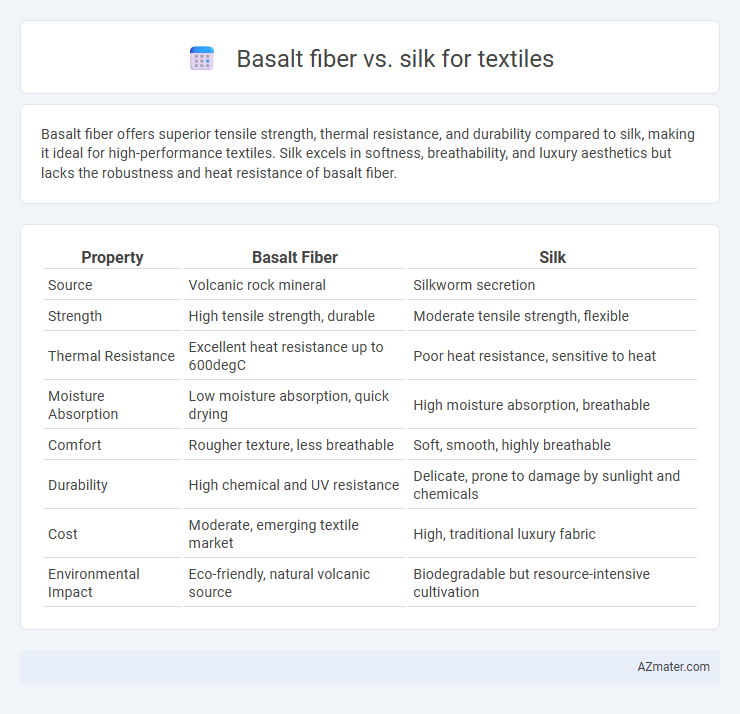Basalt fiber offers superior tensile strength, thermal resistance, and durability compared to silk, making it ideal for high-performance textiles. Silk excels in softness, breathability, and luxury aesthetics but lacks the robustness and heat resistance of basalt fiber.
Table of Comparison
| Property | Basalt Fiber | Silk |
|---|---|---|
| Source | Volcanic rock mineral | Silkworm secretion |
| Strength | High tensile strength, durable | Moderate tensile strength, flexible |
| Thermal Resistance | Excellent heat resistance up to 600degC | Poor heat resistance, sensitive to heat |
| Moisture Absorption | Low moisture absorption, quick drying | High moisture absorption, breathable |
| Comfort | Rougher texture, less breathable | Soft, smooth, highly breathable |
| Durability | High chemical and UV resistance | Delicate, prone to damage by sunlight and chemicals |
| Cost | Moderate, emerging textile market | High, traditional luxury fabric |
| Environmental Impact | Eco-friendly, natural volcanic source | Biodegradable but resource-intensive cultivation |
Introduction to Basalt Fiber and Silk
Basalt fiber, derived from volcanic rock, offers exceptional thermal stability, high tensile strength, and resistance to chemical corrosion, making it an innovative material for technical textiles. Silk, a natural protein fiber produced by silkworms, is renowned for its smooth texture, breathability, and luxurious appearance, widely used in fashion and high-end textiles. Comparing basalt fiber and silk highlights the contrast between a durable, eco-friendly mineral fiber and a soft, biodegradable natural fiber with distinct performance and aesthetic properties.
Overview of Production Processes
Basalt fiber is produced by melting basalt rocks at temperatures around 1,400degC and then extruding them into continuous filaments, a process that requires less water and chemicals compared to traditional fiber manufacturing. Silk production involves sericulture where silkworms spin cocoons made of fibroin protein, which are then carefully harvested, boiled, and spun into delicate threads. The basalt fiber production process emphasizes sustainability and high thermal resistance, while silk production highlights the biological and labor-intensive nature of natural fiber extraction.
Physical Properties Comparison
Basalt fiber exhibits superior tensile strength, thermal resistance up to 650degC, and excellent chemical stability compared to silk, which has moderate tensile strength and low thermal resistance around 150degC. Basalt fiber's high elasticity and abrasion resistance make it ideal for industrial textiles, while silk provides natural softness, flexibility, and moisture absorption. The density of basalt fiber is approximately 2.6-2.8 g/cm3, heavier than silk's 1.3 g/cm3, impacting fabric weight and durability in textile applications.
Mechanical Strength and Durability
Basalt fiber exhibits significantly higher tensile strength and modulus compared to silk, making it ideal for applications requiring enhanced mechanical performance. Its superior resistance to heat, UV radiation, and chemical corrosion contributes to exceptional durability in harsh environments. In contrast, silk offers excellent flexibility and softness but lacks the mechanical robustness and long-term durability characteristic of basalt fiber in textile applications.
Thermal and Chemical Resistance
Basalt fiber exhibits superior thermal resistance, withstanding temperatures up to 700degC without degradation, compared to silk, which can tolerate temperatures only up to approximately 150degC before damage occurs. Chemically, basalt fiber is highly resistant to acids, alkalis, and solvents, making it ideal for harsh environments, while silk is prone to damage from exposure to strong chemicals and prolonged moisture. These properties make basalt fiber a more durable choice for textiles requiring enhanced heat and chemical resistance.
Environmental Impact and Sustainability
Basalt fiber, derived from natural volcanic rock, offers significant environmental advantages over silk due to its low-energy production process and recyclability, minimizing carbon emissions and waste. Silk production involves silkworm cultivation, which demands intensive water and land resources while generating more greenhouse gases and ethical concerns regarding animal welfare. Basalt fiber's durability and biodegradability position it as a more sustainable textile alternative, promoting reduced environmental footprint throughout its lifecycle compared to traditional silk fabrics.
Cost Analysis and Market Availability
Basalt fiber offers a more cost-effective alternative to silk, with raw material costs significantly lower due to abundant volcanic rock sources, making it particularly attractive for large-scale textile production. Market availability of basalt fiber is expanding rapidly, driven by growing industrial applications and sustainability demands, while silk remains limited by traditional sericulture processes and higher labor costs. Cost analysis reveals basalt fiber's competitive edge in price stability and scalability, positioning it as a versatile option amid fluctuating silk prices and constrained supply chains.
Applications in the Textile Industry
Basalt fiber offers superior thermal resistance, durability, and environmental sustainability, making it ideal for industrial textiles, automotive interiors, and fire-resistant fabrics. Silk remains prized for its natural sheen, softness, and moisture-wicking properties, often utilized in luxury apparel, high-end home textiles, and delicate accessories. The textile industry increasingly integrates basalt fiber in technical and protective textiles, while silk dominates in fashion-focused, comfort-driven applications.
Comfort and Wearability Factors
Basalt fiber offers superior thermal insulation and moisture-wicking properties compared to silk, enhancing comfort in active and outdoor wear. Silk provides exceptional softness and breathability, making it ideal for lightweight, delicate garments with high wearability. While basalt fiber excels in durability and resistance to abrasion, silk remains preferred for its smooth texture and natural hypoallergenic qualities.
Future Trends and Innovations
Basalt fiber is gaining momentum in the textile industry due to its exceptional thermal stability, strength, and eco-friendly production process, positioning it as a sustainable alternative to traditional fibers like silk. Innovations in basalt fiber spinning and blending techniques are enabling the creation of lightweight, durable fabrics suitable for advanced applications such as protective clothing and smart textiles. Future trends highlight increased investment in basalt fiber research, aiming to enhance its softness and dyeability to compete directly with the versatility and luxury appeal of silk.

Infographic: Basalt fiber vs Silk for Textile
 azmater.com
azmater.com